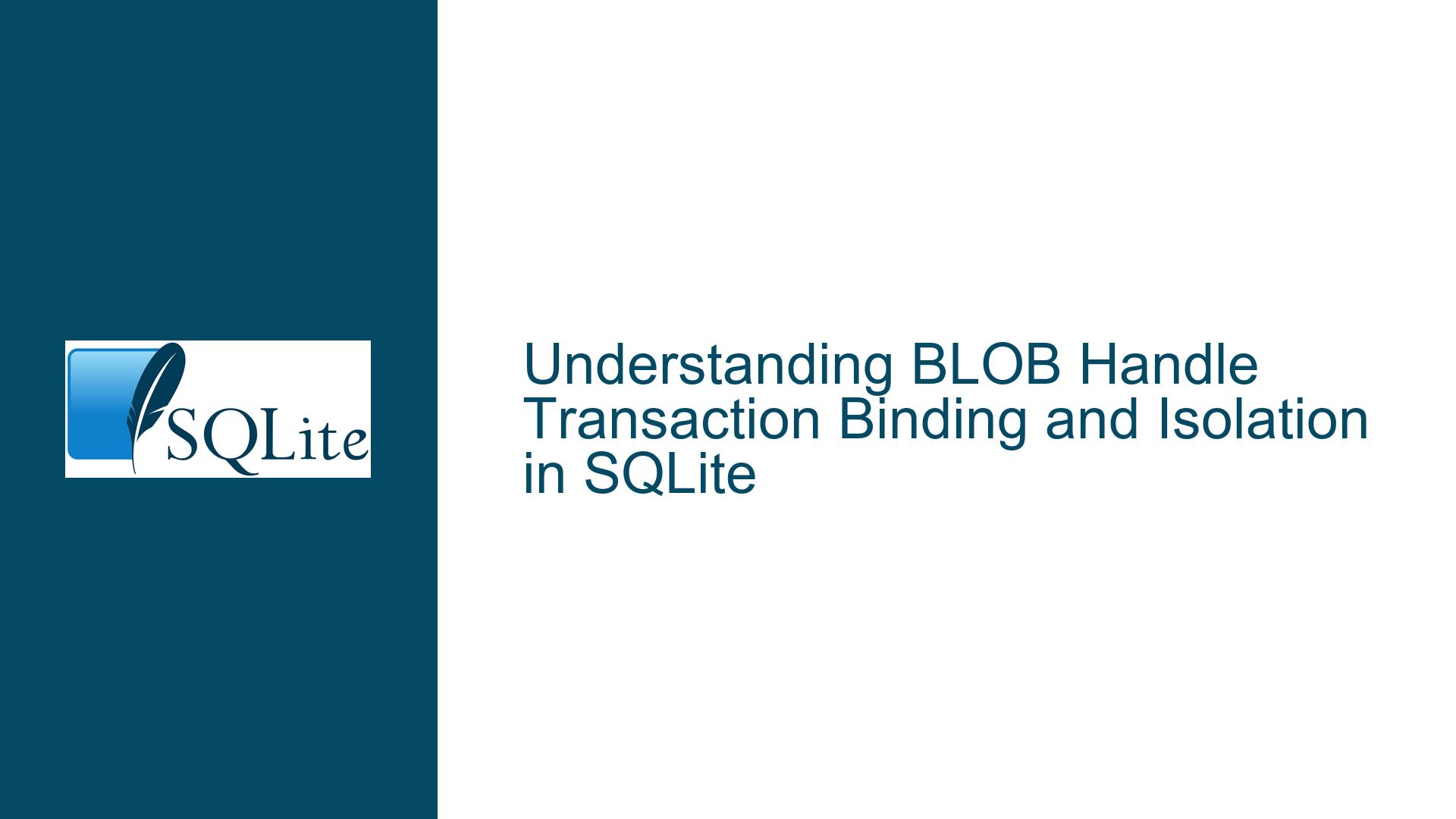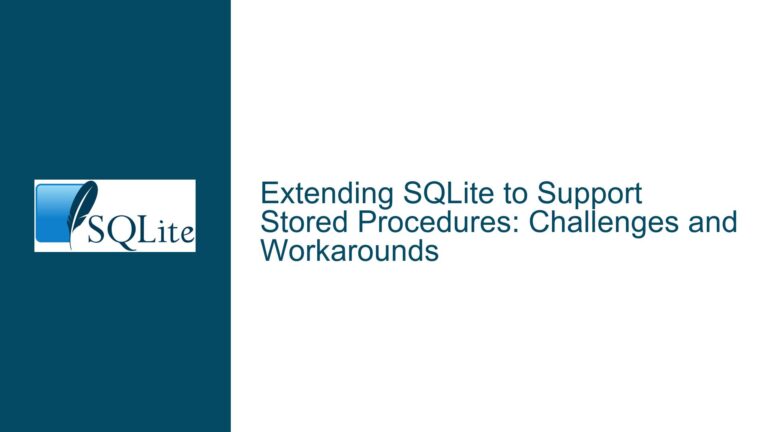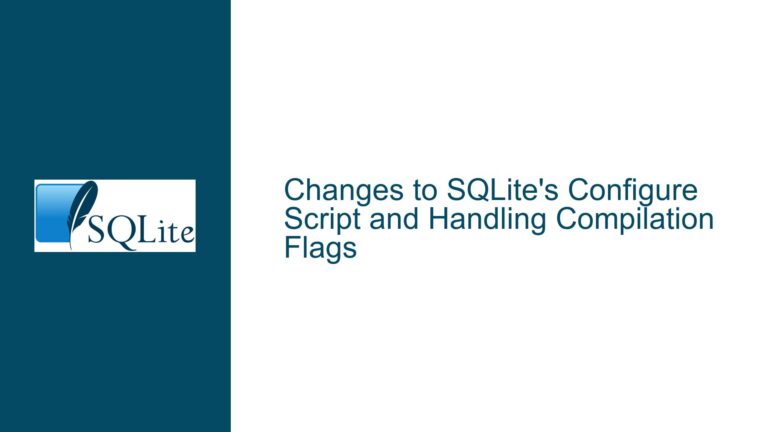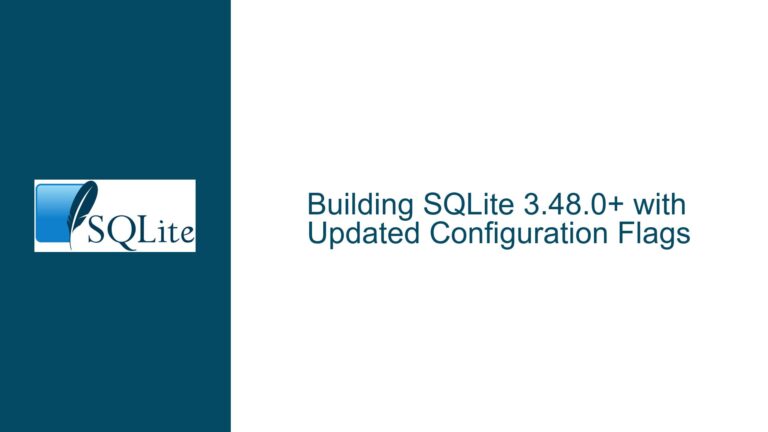BLOB Handle Transaction Binding and Isolation in SQLite
BLOB Handle Transaction Semantics and Isolation Levels: Core Interactions Explained
The integration of SQLite’s incremental BLOB I/O API within transactional workflows presents a nuanced challenge, particularly when mixing blob operations with conventional SQL statements. This analysis dissects the transaction binding characteristics of BLOB handles, their isolation guarantees, and practical solutions for maintaining data consistency.
Transactional Context of BLOB Handles and Concurrent Modification Risks
Key Concept: BLOB handles operate within the transaction scope where they were opened but exhibit unique durability characteristics compared to standard prepared statements. When a sqlite3_blob_open call succeeds, the handle becomes implicitly bound to the current database connection’s active transaction state at the time of opening. This binding persists until handle closure or transaction termination, whichever comes first.
Critical Interaction Points:
Transaction Scope Inheritance:
BLOB handles inherit the isolation level of the transaction active during their creation. A handle opened during aBEGIN EXCLUSIVEtransaction will maintain serializable isolation for its operations, while one created in aBEGIN DEFERREDtransaction operates under read-committed semantics for writes.Write Visibility Rules:
Modifications made throughsqlite3_blob_writebecome immediately visible to subsequent operations within the same transaction, even before commit. This contrasts with standard UPDATE statements where changes are only visible after statement completion due to statement-level transaction wrapping.Expiration Triggers:
Any direct modification to the BLOB’s host row via SQL statements (UPDATE/DELETE) invalidates all open BLOB handles referencing that row. Subsequent read/write operations on expired handles returnSQLITE_ABORT, but crucially, prior writes through the handle remain part of the transaction’s pending changes.
Example Failure Scenario:
sqlite3_blob_open(..., &blob_handle); // Opened during active transaction
sqlite3_blob_write(blob_handle, data, len, 0); // Writes to transaction buffer
sqlite3_exec(db, "UPDATE files SET metadata = 'modified' WHERE rowid = ?", ...); // Invalidates blob_handle
sqlite3_blob_write(blob_handle, more_data, len, 4096); // Fails with SQLITE_ABORT
sqlite3_exec(db, "COMMIT"); // First write persists, second never occurred
Implications:
The partial write scenario demonstrates that BLOB handle expiration doesn’t roll back successful prior writes through that handle. Developers must sequence BLOB operations after all SQL-based modifications to the host row to prevent premature invalidation.
Isolation Level Conflicts and BLOB Handle Durability Guarantees
Core Challenge: SQLite’s transactional isolation levels (DEFERRED, IMMEDIATE, EXCLUSIVE) interact unexpectedly with BLOB handles due to their direct page access nature. The WAL (Write-Ahead Log) mode introduces additional complexity through its versioning system.
Isolation Breakdown:
Read Uncommitted (Default):
BLOB reads viasqlite3_blob_readcan access uncommitted changes from other transactions if they modify pages already loaded into the pager cache. This violates the expected read-committed isolation when using standard queries.Repeatable Read (EXCLUSIVE Transactions):
While SQLite doesn’t formally support repeatable read, holding an exclusive transaction lock allows BLOB handles to maintain consistent views of the database. However, this comes at the cost of concurrency.Write Skew Vulnerabilities:
Concurrent transactions modifying different BLOBs in the same row can create write skew anomalies not preventable by SQLite’s locking mechanisms. For example:-- Transaction A sqlite3_blob_write(blob_handle_A, data_A, ...); // Modifies first 4KB -- Concurrent Transaction B sqlite3_blob_write(blob_handle_B, data_B, ...); // Modifies next 4KB -- Both commit successfully, creating an unexpected merged result
Mitigation Strategies:
Explicit Locking Protocol:
Implement application-level locking for BLOB ranges using a separate lock table:CREATE TABLE blob_locks( rowid INTEGER PRIMARY KEY, range_start INTEGER NOT NULL, range_end INTEGER NOT NULL, CHECK(range_start < range_end) );Acquire advisory locks via
INSERT ... ON CONFLICT FAILbefore BLOB access.Pessimistic Transaction Ordering:
Structure transactions to modify BLOB-containing rows only after all other operations, minimizing the window for concurrent modification.Checksum Validation:
Store BLOB checksums in separate columns, verified post-write to detect concurrent modifications:sqlite3_blob_write(handle, data, len, offset); uint32_t crc = calculate_crc(data, len); sqlite3_exec(db, "UPDATE files SET crc = ? WHERE rowid = ?", crc, rowid);
Transaction-Aware BLOB Handling: Lifecycle Management and Error Recovery
Lifecycle Phases:
Acquisition:
Open BLOB handles only after establishing a transaction savepoint. This allows partial rollback of BLOB writes without aborting the entire transaction:sqlite3_exec(db, "SAVEPOINT blob_write"); sqlite3_blob_open(db, "main", "files", "data", rowid, 1, &handle); // ... perform writes ... if (error) { sqlite3_exec(db, "ROLLBACK TO blob_write"); } else { sqlite3_exec(db, "RELEASE blob_write"); }Error Recovery:
Implement retry loops with exponential backoff when encounteringSQLITE_BUSYorSQLITE_ABORTerrors. For expired handles:int attempts = 0; do { rc = sqlite3_blob_write(handle, data, len, offset); if (rc == SQLITE_ABORT) { sqlite3_blob_reopen(handle, new_rowid); // If rowid changes attempts++; usleep(1000 * (1 << attempts)); // Exponential backoff } } while (rc == SQLITE_ABORT && attempts < MAX_RETRIES);Commit Coordination:
Manually flush BLOB handle buffers before transaction commit to ensure all writes are durably stored. SQLite doesn’t automatically flush pending blob writes on commit:sqlite3_blob_write(handle, final_data, final_len, final_offset); sqlite3_blob_bytes(handle); // Forces buffer flush to database sqlite3_exec(db, "COMMIT");
Advanced Technique – BLOB Write Journaling:
Maintain a side journal of BLOB modifications to enable atomic updates across multiple handles:
struct blob_journal_entry {
sqlite3_blob* handle;
size_t offset;
void* data;
size_t len;
};
void atomic_blob_commit(sqlite3* db, blob_journal_entry* entries, size_t count) {
sqlite3_exec(db, "BEGIN IMMEDIATE");
for (size_t i = 0; i < count; ++i) {
sqlite3_blob_write(entries[i].handle, entries[i].data, entries[i].len, entries[i].offset);
}
sqlite3_exec(db, "COMMIT");
}
Critical Best Practices:
- Always open BLOB handles in
READ WRITEmode (sqlite3_blob_openfinal parameter = 1) even for read-only access to prevent handle invalidation during mixed read/write transactions. - Set a strict statement timeout using
sqlite3_busy_timeout()to prevent indefinite blocking on BLOB operations. - Use
PRAGMA cell_size_check=ONto validate BLOB sector writes, particularly when working with partial updates.
Comprehensive Solution Framework for Transactional BLOB Management
Architecture Design:
BLOB Access Proxy Layer:
Implement an intermediate layer that wraps all BLOB operations with transaction state checks:typedef struct { sqlite3* db; sqlite3_blob* handle; int64_t rowid; const char* schema; const char* table; const char* column; } ManagedBlob; void managed_blob_write(ManagedBlob* mblob, const void* data, int len, int offset) { if (sqlite3_get_autocommit(mblob->db)) { sqlite3_exec(mblob->db, "BEGIN EXCLUSIVE"); } if (sqlite3_blob_reopen(mblob->handle, mblob->rowid) != SQLITE_OK) { sqlite3_blob_close(mblob->handle); sqlite3_blob_open(mblob->db, mblob->schema, mblob->table, mblob->column, mblob->rowid, 1, &mblob->handle); } sqlite3_blob_write(mblob->handle, data, len, offset); }Transaction State Mirroring:
Maintain a shadow transaction stack that parallels SQLite’s native transaction states:#define MAX_TXN_DEPTH 32 typedef struct { int depth; char* savepoints[MAX_TXN_DEPTH]; sqlite3_blob* open_blobs[MAX_TXN_DEPTH][MAX_BLOBS_PER_TXN]; } TransactionState; void begin_transaction(TransactionState* ts, sqlite3* db) { if (ts->depth == 0) { sqlite3_exec(db, "BEGIN"); } else { char sp_name[32]; snprintf(sp_name, sizeof(sp_name), "blob_sp_%d", ts->depth); sqlite3_exec(db, "SAVEPOINT %s", sp_name); ts->savepoints[ts->depth] = strdup(sp_name); } ts->depth++; }BLOB Handle Replication:
For high-availability systems, implement leader-follower BLOB replication using SQLite’s online backup API combined with incremental BLOB I/O:void replicate_blob(sqlite3* source, sqlite3* dest, int64_t rowid) { sqlite3_blob* src_blob, * dest_blob; sqlite3_blob_open(source, "main", "files", "data", rowid, 0, &src_blob); int blob_size = sqlite3_blob_bytes(src_blob); void* buffer = malloc(blob_size); sqlite3_blob_read(src_blob, buffer, blob_size, 0); sqlite3_exec(dest, "BEGIN EXCLUSIVE"); sqlite3_blob_open(dest, "main", "files", "data", rowid, 1, &dest_blob); sqlite3_blob_write(dest_blob, buffer, blob_size, 0); sqlite3_exec(dest, "COMMIT"); free(buffer); sqlite3_blob_close(src_blob); sqlite3_blob_close(dest_blob); }
Performance Optimization:
Batched Writes: Aggregate small BLOB writes into larger operations to minimize SQLITE_BUSY collisions:
#define BLOB_BATCH_SIZE 16 struct blob_write_batch { sqlite3_blob* handle; size_t offsets[BLOB_BATCH_SIZE]; void* data[BLOB_BATCH_SIZE]; size_t lengths[BLOB_BATCH_SIZE]; int count; }; void batch_blob_write(struct blob_write_batch* batch) { if (batch->count == 0) return; sqlite3_exec(batch->handle->db, "BEGIN"); for (int i = 0; i < batch->count; ++i) { sqlite3_blob_write(batch->handle, batch->data[i], batch->lengths[i], batch->offsets[i]); free(batch->data[i]); } sqlite3_exec(batch->handle->db, "COMMIT"); batch->count = 0; }Asynchronous Flushing: Utilize background threads with dedicated database connections to flush BLOB writes from memory buffers, leveraging the write-ahead log’s append-only nature.
Concurrency Control Matrix:
| Operation | Read Transaction | Write Transaction | Exclusive Transaction |
|---|---|---|---|
| BLOB Read | Allowed | Allowed | Allowed |
| BLOB Write | SQLITE_BUSY | Allowed | Allowed |
| SQL Read | Allowed | Allowed | Allowed |
| SQL Write | SQLITE_BUSY | SQLITE_BUSY | Allowed |
Key Insight: BLOB writes have higher priority than SQL writes in concurrent scenarios due to their direct page access nature. This necessitates careful sequencing of operations to prevent deadlocks.
Final Recommendations:
- Always pair BLOB handle operations with explicit transaction boundaries rather than relying on auto-commit mode.
- Use
SAVEPOINTfor nested BLOB modifications to enable partial rollback. - Implement handle lifetime tracking using smart pointers or RAII patterns to prevent leaks during error conditions.
- Regularly vacuum the database when using large BLOBs with frequent partial updates to maintain page locality.
- Consider using the
SQLITE_DIRECT_OVERFLOW_READcompile-time option to bypass the page cache for large BLOB reads, improving performance at the cost of transaction isolation.
This comprehensive approach ensures robust transactional BLOB handling while maximizing performance and maintaining SQLite’s renowned reliability characteristics. Developers should rigorously test their implementation under load using tools like the SQLite Test Harness while monitoring for SQLITE_PROTOCOL errors which indicate transaction state mismatches.






